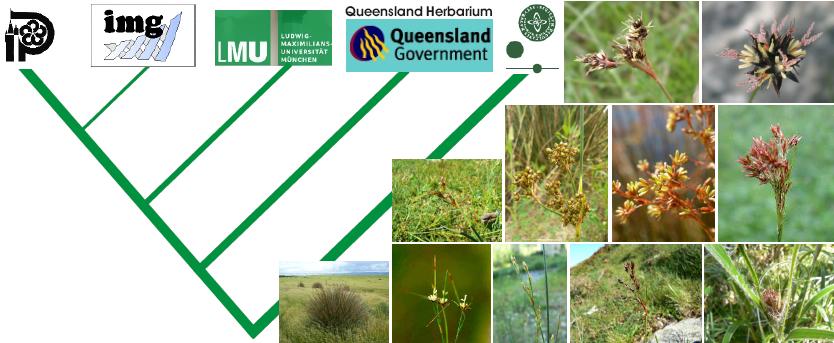 Juncaceae Phylogeny Group
Juncaceae Phylogeny Group
Juncus -
KEY
TO SUBGENERA AND SECTIONS
1
Inflorescence racemose, a pair of floral bracteoles
absent, flowers
usually in heads or clusters, rarely borne ±singly (subg.
Juncus)
2
Leaves terete, stem-like, pungent, basal, not septate,
vascular bundles
scattered over most of T.S., lower bract apparently forming a
prolongation of
stem sect. 1. Juncus
2:
Leaves flat, compressed, canaliculate or if terete, then usually
septate, not
stem-like, basal or cauline, vascular bundles usually in subepidermal
position,
lower bract usually not in a position of the stem prolongation
3
Leaves unitubulose or pluritubulose, perfectly septate; if
pluritubulose
(not bitubulose) and imperfectly septate, then terete, or flattened but
then not
arranged perpendicular to stem sect.
6. Ozophyllum
3:
Leaves flat or with raised margins, not septate, or bitubulose and
septate, or
laterally compressed and pluritubulose and imperfectly septate (then
arranged
perpendicular to stem), if unitubulose and perfectly septate then
anthers
distinctly exserted
4
Annuals
sect.
3. Caespitosi
4:
Perennials
5
Anthers distinctly to at least partly exserted from
perianth in later
stages of flowering
sect. 4. Stygiopsis
5:
Anthers not exserted
6
Most of inflorescence not fertile, of golden-coloured
feather-like
branchlets sect.
4. Stygiopsis
(J. ochraceus)
6:
Inflorescence usually fully fertile, not of the above appearance
7
Leaves laterally compressed, pluritubulose, imperfectly
septate, arranged
perpendicular to stem
sect.
5. Iridifolii
7:
Leaves dorsiventrally compressed or ±canaliculate, not
septate, arranged
adaxial flat side facing the stem
8
Seeds with two distinct appendages. Sino-Himalayan
region sect.
4. Stygiopsis
8:
Seeds without appendages, if appendages present then W North
America
sect. 2. Graminifolii
1:
Inflorescence cymose, a pair of floral bracteoles present below each
flower,
flowers usually borne singly or in loose groups (subg.
Agathryon)
9
Annuals sect.
7. Tenageia
9:
Perennials
10
Inflorescence seemingly lateral (pseudolateral), lower
inflorescence
bract terete, erect, seeming to be a continuation of stem, basal leaves
bladeless; cauline leaves ±absent, sterile shoots terete,
stem-like
sect. 9. Juncotypus
10:
Inflorescence obviously terminal, lower bract flat, canaliculate or
terete, not
as a continuation of stem, at least some basal or subbasal leaves with
a well
developed blade, sterile shoots not stem-like
11
Cauline leaves terete (epidermal cells of the same size),
pith of
astericiform cells
sect.
10. Forskalina
11:
Cauline and/or basal leaves flat to canaliculate (at least some cells
od adaxial
epidermis enlarged, margins with thin sclerenchymatous strands), the
inner part
of leaves of chlorenchyma, rarely with air channels, not of
astericiform cells
sect. 8. Steirochloa